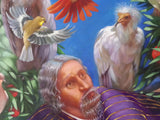The Restoration of Isaac to His Father Abraham
Note cards
by Rosemarie Adcock
This painting by Rosemarie Adcock depicts one of the most famous stories in history, that of the patriarch Abraham and the ultimate test of his faith in God. This man was called by God to leave his family and go to a place that God was to show him, difficult enough to be far from family and friends, but certainly more so in ancient times without the assurance of basic food and water. Abraham was a wealthy man, but for all his wealth the one thing he didn't have was a child, even though God had spoken to him of having many descendants. In his old age, when all hope was long gone, finally, by a miracle, a son Isaac was born to him and his aging wife.
The day came that God instructed Abraham to sacrifice the young man, an unthinkable act practiced by the pagans of his ancient culture, yet in utter obedience (likely in complete horror) Abraham prepared to do exactly that, knife raised, until an angel stopped him and declared he shouldn't harm the boy. In that very moment, Abraham saw that there was a ram caught in some branches, which was to be the sacrifice God provided in place of the precious son Isaac.
The artist chose to call the painting The Restoration of Isaac because essentially, in the mind of the father, the boy was already sacrificed; the decision had been made to give him up; he was willing to give up everything and anything God required of him. The part of this story that has always been so precious to me is the part that speaks of God's faithfulness to us even today, the restoration of the very thing we gave up on, the thing truly dead to us, brought back to life. A verse that refers back to this story says it well: "...Even God, who gives life to the dead and calls into being that which doesn't exist."
Frightened rabbits flee in the foreground, birds wait for the outcome, vultures await their prey, a blue fox stares out at us, bringing us into the painting to consider our own precious things and admire the faith of a man who was called "the friend of God."



















